Sayn is a district of Bensdorf and is located just under 12 kilometers from Koblenz. You should definitely plan a day trip to Sayn during a visit to the Romantic Rhine.

Sayn Castle
Sayn Castle, the former ancestral seat of the Counts of Sayn, stands at the foot of the castle hill of the now ruined Sayn Castle. In the 14th century, a medieval castle manor was initially built there for the Lords of Reiffenberg.

To be honest, I find the family history of the noble family very complicated, but Sayn becomes Sayn-Wittgenstein, Sayn-Wittgenstein-Sayn,… In 1753 the house fell by marriage to Baron Boos von Waldeck, who had it rebuilt into a baroque manor house.
Prince Ludwig zu Sayn-Wittgenstein-Sayn returned from Russia to the family’s old home in 1848 with his Russian wife, Princess Leonilla Barjatinsky. He bought the estate from Count Clemens Boos von Waldeck, then District Administrator of Koblenz, and commissioned a French architect to convert the house into a neo-Gothic palace. Around 1860, a chapel was built at the east end, modeled on the Sainte-Chapelle.

During the Second World War, the castle was so badly damaged that it was uninhabitable. It fell into disrepair and only the chapel and the crypt underneath, which was the burial place of the Sayn princely house, remained almost undamaged.
In the 1990s, Alexander Prince zu Sayn-Wittgenstein-Sayn, the current lord of the castle, planned the reconstruction. Since 2000 the castle shines again in its old splendor in Sayn.

Castle Museum
A good 1000 m² had become available after the Rhenish Iron Art Casting Museum moved out of Sayn Castle. Enough space to create the New Museum in Sayn Castle. Princess Gabriela and Prince Alexander zu Sayn-Wittgenstein-Sayn show a successful exhibition on the family history in the museum.
When we arrived at the castle, the Princess and the Prince welcomed us to tell us the history of the house personally. Afterwards, the Princess guided us through the exhibition and admittedly, that made the visit really unique. If you go through the exhibition alone or with the “DigiWalk” app, you can learn a lot, but on this tour, the Princess told us a lot that can’t be read about.

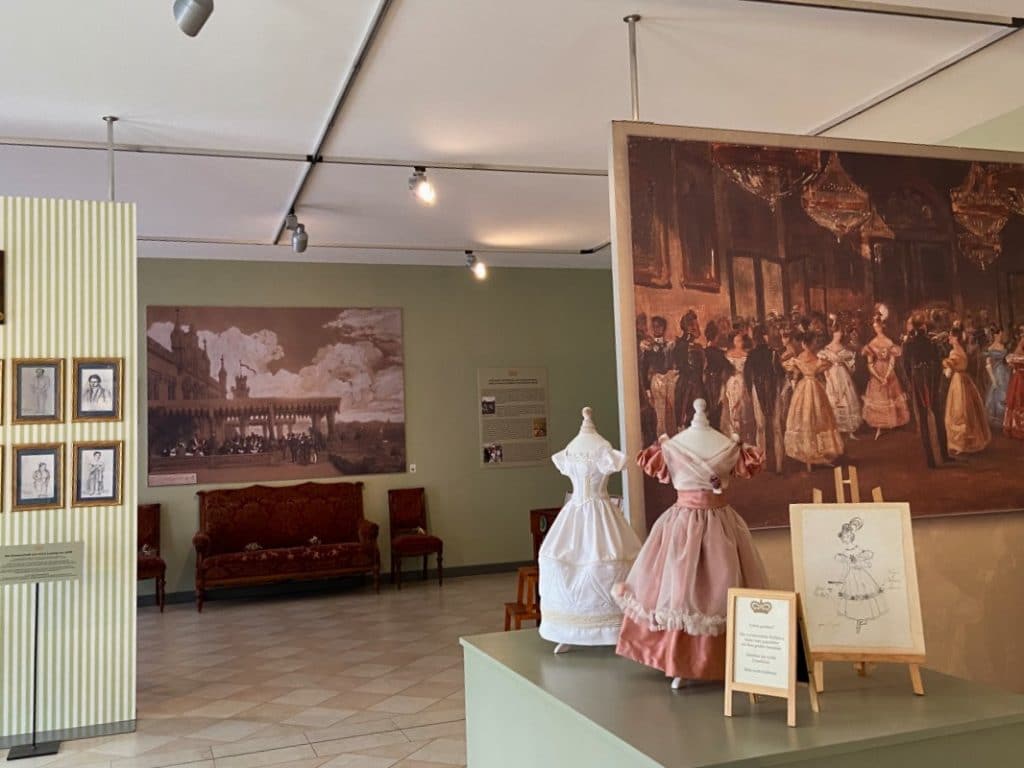
The main themes of the exhibition are the princesses Leonilla (1816-1918) and Marianne (mother of the prince).
Princess Leonilla and her life are lovingly presented in the exhibition. I found her wedding dresses particularly impressive.


From the Princess Marianne, an avid photographer, you can discover beautiful photographs. Particularly interesting are the photographs taken, for example, during the family’s great hobby, motor sports, or the pictures of numerous prominent friends of the family.

We ended our tour of the castle with a look into the castle chapel. The chapel was built especially for the storage of the precious arm relic of St. Elisabeth. I particularly like the textile wall hangings, which make the room look very “warm”.
From the castle it is only a short walk that took us to the castle pak.
Garden of butterflies in the castle park
After the castle was rebuilt in the middle of the 19th century, it was decided to redesign the approximately 7 hectares of gardens in front of the castle. Rare trees were planted and a castle pond with a fountain was created.

In 1987, a butterfly house was created. Princess Gabriela zu Sayn-Wittgenstein-Sayn created a garden of butterflies in two glass pavilions, which today delights numerous visitors. Over the years, a nature trail has been created around the butterfly house. Various habitats for small animals are presented here.
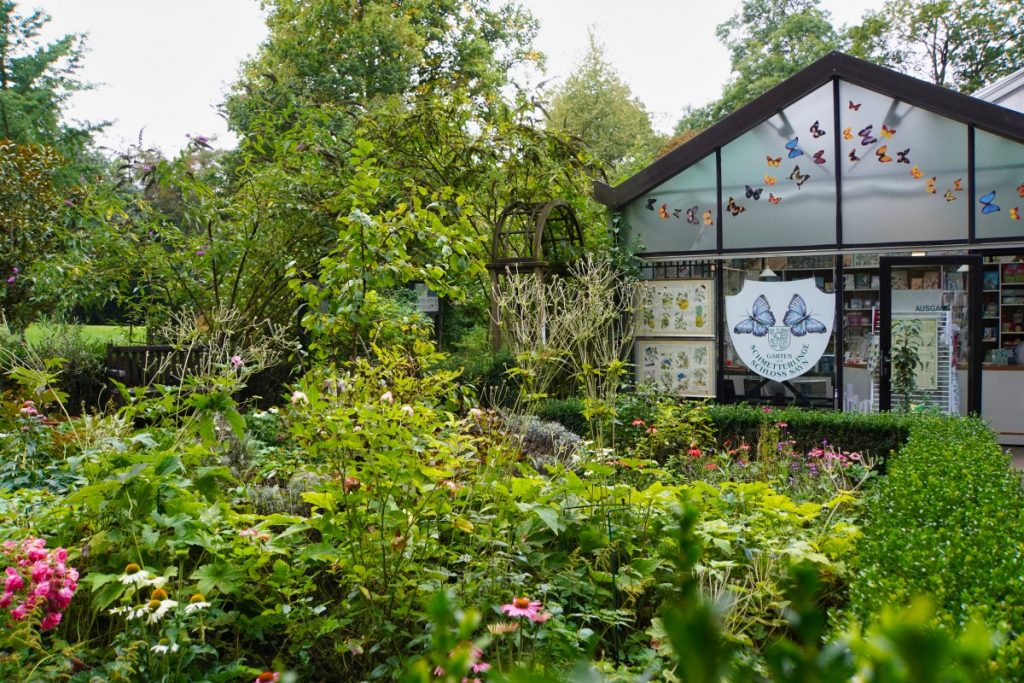
Before going to the butterfly garden, you pass through small landscaped gardens. In the herb garden you can discover the most famous domestic and Mediterranean culinary herbs.
Once you have entered the house through a small lock, you find yourself in a small paradise. Tropical plants are in bloom and a path leads you through the garden under palm trees. The path is barrier-free and numerous benches invite you to linger.

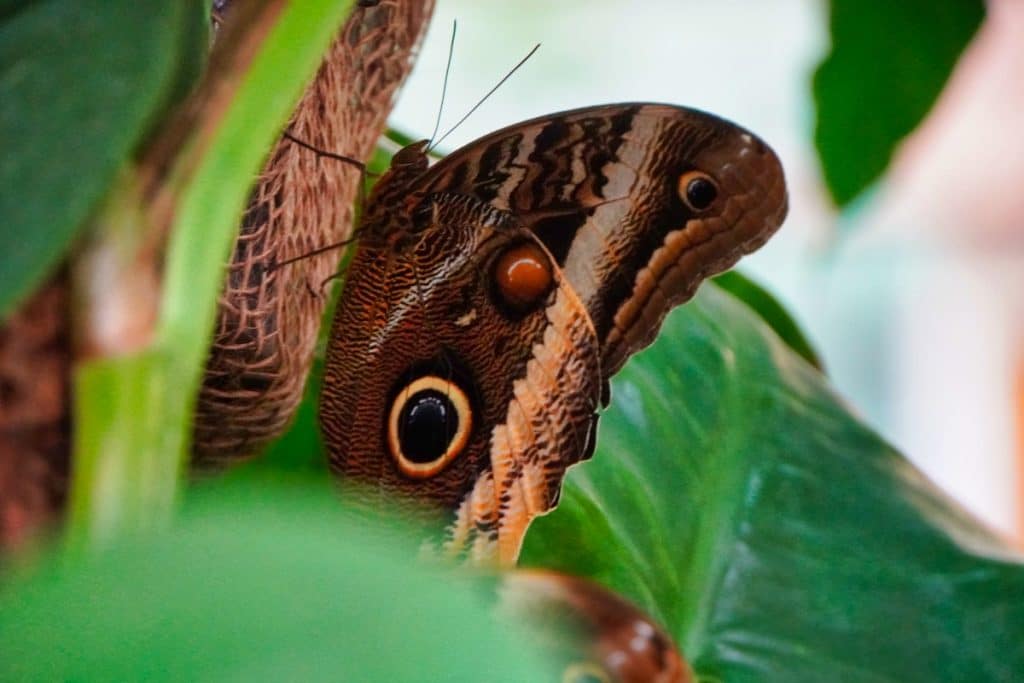
Around the visitor flutter countless colorful butterflies and you really have to pay close attention and also look at the path and not only in the air. It can happen that dwarf quails with their chicks scurry past, a turtle takes a break in the middle of the path or colorful finches hop around.
From March to November, numerous different butterflies flutter through the glass pavilions. If you move slowly, they settle on the leaves of the plants or at one of the numerous feeding stations. Then you can observe the beautiful animals in peace.


Address:
Schloßstraße 100
56170 Bendorf
Car park of the Garden of Butterflies Sayn Castle:
Koblenz-Olper-Straße 159
56170 Bendorf
Opening hours:
March until end of September: 10 -18 h
October: 10-17 h
November: 10-16 h
Museum
additionally Advent weekends and 26/27 Dec. from 11am-5pm
Admission fees:
Garden of Butterflies and New Museum Sayn Castle
Adults: 12,-€
Discounts are offered. The ticket can be used on different days during a season.
Sayner Hütte
Not far from the butterfly garden is the Sayner Hütte, a former ironworks.
In the years 1769-1770, an iron foundry with blast furnaces and a hammer was built in Sayn on behalf of the then Elector of Trier. From 1815 to 1865, the Sayn ironworks was owned by Prussia and developed into one of the most important iron foundries during this period.

In addition to the smelter building with the blast furnaces, there was also a moulding house, a hammer building with two hammers, a hammer building with hammer and stretching hammer, storage buildings and a residential building. Around 1828, a new casting hall with a blast furnace was built. This is still preserved today and can be visited. After Alfred Krupp took over the Sayner Hütte in 1865, there were initially some extensions to the site, but he shut down the blast furnace as early as 1878. In 1926, operations were finally discontinued. Since 2004, the town of Benzdorf has been the owner of the site and has worked out a new concept for its use together with the Friends of the Sayner Ironworks.
A look inside the Sayner Hütte
The so-called Krupp Hall is the entrance to the Sayner Hütte site. This building was erected around 1908/1909. It was used for the mechanical processing of iron castings, the production and processing of iron and steel end products.

Since 2017, an exhibition and event hall has been located here. In the entrance area, there is a model of the hut grounds that helps you to find your way around. I really liked the slideshow, which illustrates the various construction phases and the development of the site. An exhibition provides an overview of the Sayner Hütte.
Casting hall
An architecturally impressive casting hall was built in Sayn from 1828-1830. Prefabricated cast-iron elements were used for the construction and a hall of 24×29 metres was created. This was later extended to over 43 metres.
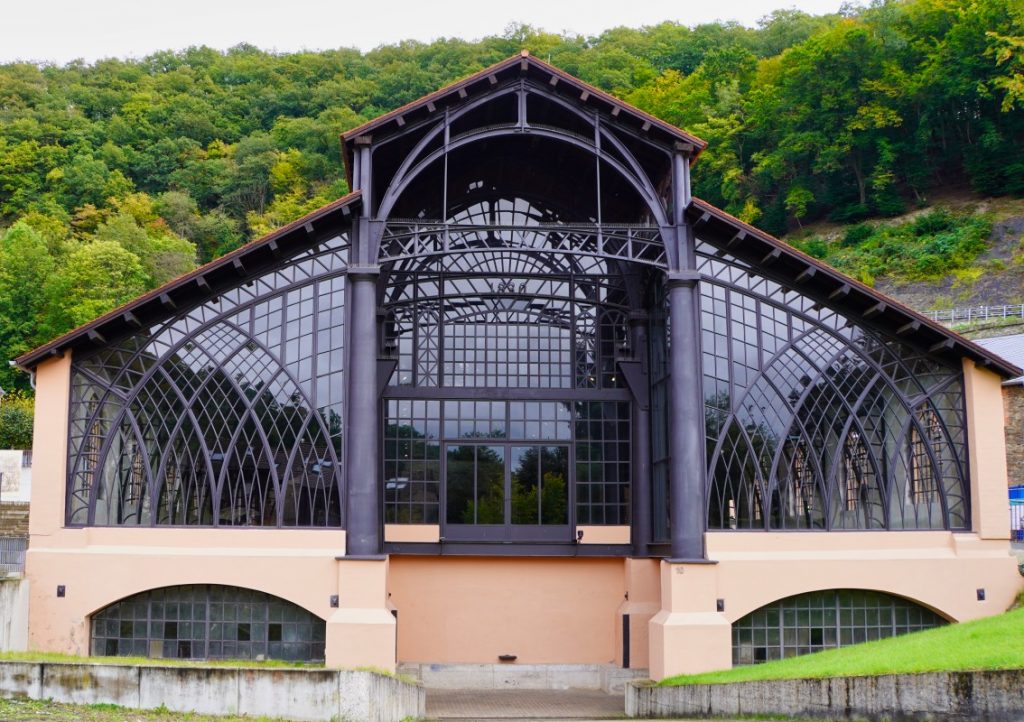
The building somewhat resembles the church of a three-aisled basilica, except that it is made of steel and not stone. The central structure is somewhat elevated, there are columns over 6 metres high with Doric capitals and the blast furnace stands in the “apse”. The front end of the hall is characterised by a glass wall divided by iron ribs and pointed arches. A beautiful sight that makes the casting hall a unique building to this day.
At the time when iron was still worked here, about 170 workers were employed at the Sayner Hütte. I find it particularly exciting that all the machines at the plant were powered by water.

A media “blast furnace production” is played at regular intervals in the casting hall. This shows the work in the casting hall. Unfortunately, our stay was too short to experience the production. I would have liked to see how the project was realised.
I can recommend a visit to the platform at the blast furnace. A lift or a few steps take you high above the hall and you can admire the impressive roof construction and the size of the hall.

Today, the industrial monument is a museum and event hall. You can find out about current events on the Sayner Hütte website.
Address:
In d. Sayner Hütte 4
56170 Bendorf
Opening hours
April – mid-October
daily 10-18 h
Admission fees
Adults: 6,- €
Discounts are offered.
The visit to Sayn was part of a blogger trip. This article was written independently of the report.


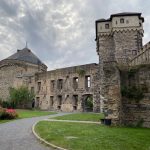




Leave a Reply